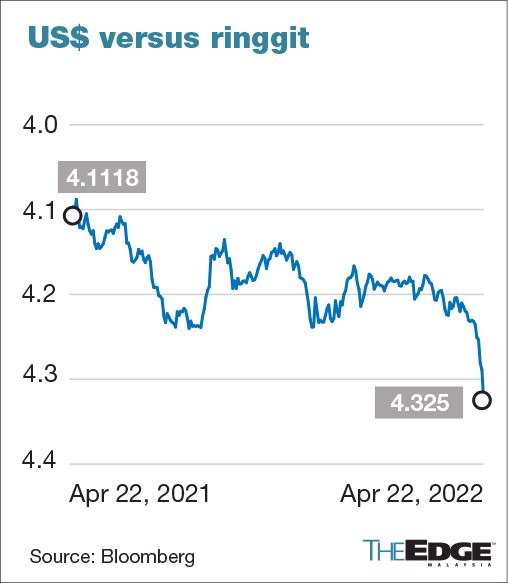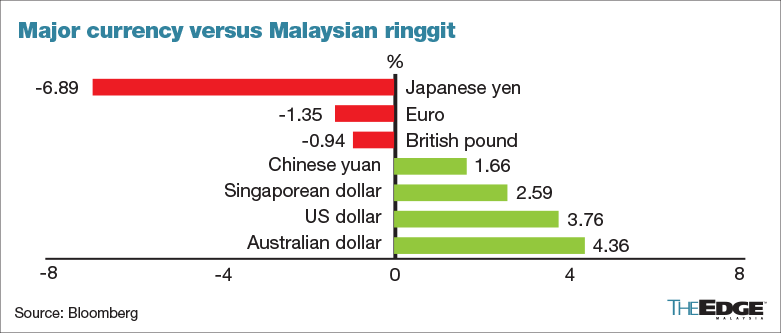
KUALA LUMPUR (April 22): The Malaysian ringgit (MYR) skids past 4.32 on Friday (April 22) against the US dollar (USD) — the lowest since May 2020 — as hawkish US Federal Reserve policy and weakening Chinese yuan hurt local currency sentiment.
The MYR, which dived to 4.2892 against the greenback on Thursday, weakened further to 4.3250 at the time of writing on Friday. This is the lowest level seen since May 29, 2020, when the MYR was trading at 4.3465 against the US dollar.
Year to date, the MYR has depreciated 3.8% against the US dollar. It was the worst performer among regional currencies.
The ringgit has also weakened against the Singapore dollar (SGD) to as low as 3.1664 on Friday from 3.1511 on Thursday, as well as against the Japanese yen (to 3.3771 from 3.3435) and the British pound (to 5.6156 from 5.603).
UOB Senior foreign exchange strategist Peter Chia told theedgemarkets.com that the MYR is facing downward pressure, alongside other Asia currencies, due to expectations of aggressive monetary tightening measures from the Fed.
The Fed is set to deliver a larger-than-usual 50 basis points rate hike in the May Federal Open Market Committee (FOMC) and may soon announce further details on their plans to reduce its balance sheet.
The recent weakness in the yuan may have also weighed on the MYR, he added.
He also said the spike in global crude oil prices is a double-edged sword for Malaysia's fiscal position, as higher oil revenues are countered by rising fuel subsidies. Due to this, the positive spillover effect of higher oil prices into the local note may get diluted.
Hence, the MYR, like other Asia currencies, has been driven more by the global liquidity withdrawal trend, led by the Fed.
“That said, Malaysia’s fundamentals remain solid. Malaysia’s strong exports growth, a benign inflation trajectory as compared with other Asian peers, as well as ample foreign reserves, are expected to cushion further declines in the ringgit,” he said.
He forecast that the MYR will settle at 4.32 against the USD by year end.
Meanwhile, DBS Bank senior currency economist Sung Seng Wee said monetary policy divergence has become a prominent theme, especially after the Japanese yen’s sharp depreciation, and the sell-off in the yuan this week.
“Our economists expect Malaysia to start hiking in the third quarter, only after the Fed has delivered two 50-basis-point hikes and started quantitative tightening in the second quarter,” Sung told theedgemarkets.com.
Apart from a sharply higher US rate outlook, he noted that currencies in emerging Asian markets traditionally underperform when the global outlook weakens.
The International Monetary Fund’s downgrade of global growth forecast to less than 4% is especially unhelpful for currencies that are export-led, he said.
In terms of the ringgit's weakness against non-USD currencies, he said the ringgit's weakness against the Singapore dollar was attributed to the Monetary Authority of Singapore’s three policy tightening since October.
“In summary, monetary policy divergences and global economic weakness offset the ringgit's allure as a commodity currency,” he said.
Unlike consensus, he said DBS had actually anticipated that the MYR would weaken to 4.30, but the currency had weakened faster than expected. "Since 2015, USD/MYR has pushed higher to 4.40 and above, after hitting 4.30," he added.
OCBC Bank rates strategist Frances Cheung said the upward move in USD/MYR is primarily driven by the broad dollar strength on the back of the Fed's hawkishness.
“The MYR did not manage to outperform, probably as the flow dynamics have not been particularly supportive. Potential bond index rebalancing inflows do not appear to have come and instead, any bond outflows may not be offset by the small equity inflows thus far this month,” she told theedgemarkets.com.
According to her, the market seems to have shifted their focus slightly away from commodity prices, as there is a recent pause in the upward move in oil prices, while uncertainties rise about China's growth.
“This is not something that impacts the MYR only. Nevertheless, the trade balance is a bigger item than portfolio flows on Malaysia’s external balance and the trade balance is likely to remain fairly supportive, which shall limit MYR weakness,” she said.
Likewise, SPI Asset Management managing partner Stephen Innes said the main reason for the fall in MYR is the hawkish Fed, which was followed closely by the protracted lockdown in China that hurt domestic growth and forced the People’s Bank of China's (PBoC) hand to weaken the yuan to boost exports, which is negative for MYR.
“If you look at oil-exporting countries' currencies like Canada, oil prices are not helping those currencies either, because of the extremely high inflationary effect of oil prices on consumer sentiment. Similarly, inflation hurts Malaysian consumers, forcing the government to drain fiscal coffers to subsidize oil prices,” he told theedgemarkets.com.
“Higher commodity prices result from supply concerns, not demand-driven concerns, so it is not as much a boost if exports don't rise. This falls back to the slower China economy argument,” he added.
As such, he is revising his target for USD/MYR due to the protracted lockdown in China, the Ukraine war, a more hawkish Fed than anticipated, and a possible regime shift in China's currency policy to let the yuan weaken.
“Last week, my target for USD/MYR was 4.22 by the end of the second quarter and 4.15 by year-end. I will now likely have to revise to 4.37 (second quarter) and 4.30 (year-end), if the yuan heads for the plunge pool,” he added.



